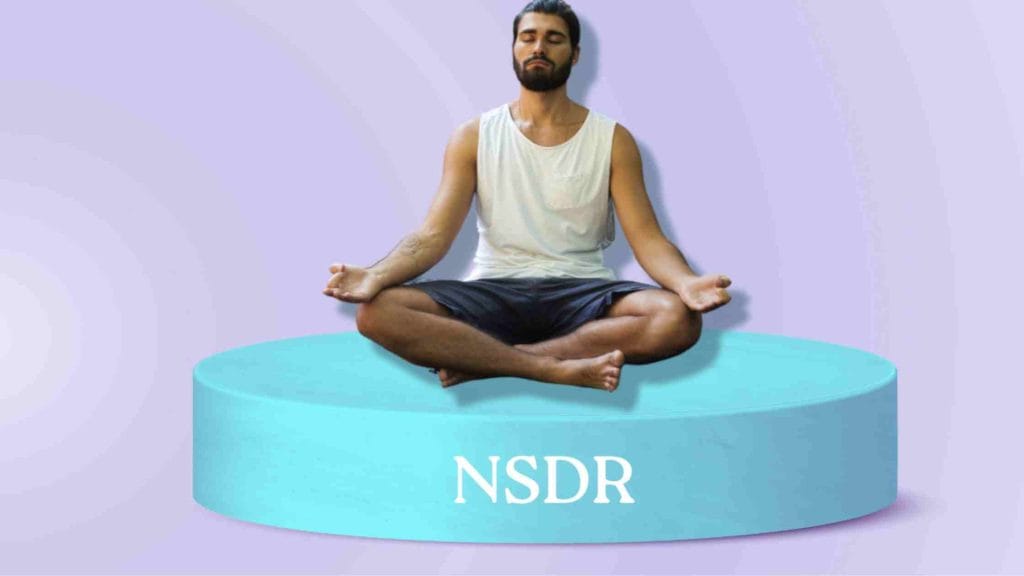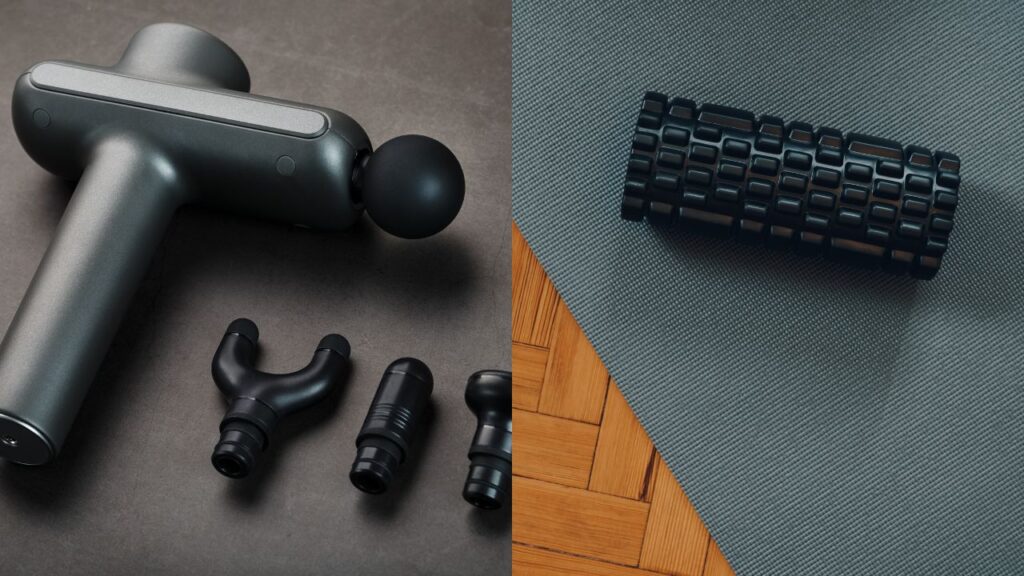Non Sleep Deep Rest (NSDR) – The Huberman Meditation Protocol You Need
We include links to products we think are useful for our readers. If you click and buy a product through one of the affiliate links on this page, we may earn a small commission.

Non Sleep Deep Rest (NSDR)
In our fast-paced lives, a sleepless night can wreak havoc on our bodies and minds, leaving us feeling groggy, irritable, and mentally foggy the following day. Chronic sleep deprivation not only impacts our day-to-day functionality but also poses potential risks to our physical and mental health. When I’m not brave enough to jump in the ice bath at home, I opt for a simple this simple practice to shift my nervous system instead. It’s like if a guided mediation and yoga nidra made love and had a baby: Non Sleep Deep Rest (NSDR).
NSDR, often referred to as yoga nidra, is a simple relaxation come mediation or mindfulness technique that enables you to reap the benefits of a restful night’s sleep without the necessity of actually falling asleep. In this article, we’ll delve into the core principles of NSDR and guide you on how to embark on this transformative practice.
Specific forms of breathing place us into relaxation by slowing the heart rate down, activating the parasympathetic state of rest and recovery, dissolving away stress. NSDR is a very simple practice that dies exactly this and can be done at home, with loads of examples of NSDR practices on Youtube and Spotify.
What Is Non Sleep Deep Rest?
Non-Sleep Deep Rest (NSDR), or yoga nidra, is a state of profound relaxation in which your body enters a deep state of rest, while your mind remains awake and alert. I have really enjoyed discovering NSDR through listening to the Huberman Lab podcast, and I seem to respond really well to these guided meditation style practices.
This practice consists of two fundamental steps: the induction of a state of profound rest and focused concentration. NSDR facilitates deep relaxation, effectively mimicking the benefits of sleep without the necessity to fall asleep. To maximise the benefits of NSDR, it is crucial to practice in a peaceful setting, free from distractions. Pro tip: I really enjoy practicing NSDR in my Infrared sauna blanket, as the added warmth allows me to really drop into the relaxed state even faster.
The term “Non-Sleep Deep Rest” was coined by Dr. Andrew Huberman, a distinguished neuroscientist and researcher at Stanford University. Dr. Huberman suggests that specific experiences can trigger a restorative state similar to sleep. Before delving into the health benefits of NSDR, it’s essential to understand the scientific underpinnings of this practice.
The Science Behind NSDR
Non-Sleep Deep Rest operates by slowing down brain wave frequencies, mirroring the patterns observed during slow-wave sleep (SWS). Slow-wave sleep, also known as deep sleep, is one of the four stages of sleep and represents the third phase of non-rapid eye movement sleep (non-REM sleep). During this stage, delta waves dominate the electroencephalogram (EEG), a device used to measure brain activity.
Slow-wave sleep plays a pivotal role in bodily rejuvenation and healing. Research indicates that during this stage, a substantial release of growth hormone occurs, promoting tissue growth, repair, and enhanced cognitive capacity. Slow-wave sleep also activates the parasympathetic nervous system, diminishing the fight-or-flight sympathetic response. This activation contributes to improvements in cardiovascular health, as reflected in metrics such as heart rate variability.
NSDR has the potential to initiate changes similar to those witnessed during slow-wave sleep. When monitored using brain activity measurement tools, NSDR induces a transition in brain waves from active beta frequencies to alpha frequencies, eventually reaching the deep meditative state characterized by theta frequencies. With sufficient practice, it is possible to reach delta frequencies, a stage typically exclusive to slow-wave sleep. By mirroring the effects of slow-wave sleep on the cerebral cortex, NSDR allows individuals to enjoy the rejuvenating effects of deep sleep without actually falling asleep.
Moreover, NSDR assumes particular significance because, even with sufficient sleep, many individuals do not experience slow-wave sleep on a daily basis. Therefore, NSDR not only emulates the effects of slow-wave sleep but also has the potential to enhance overall sleep quality, making it an integral component of good sleep hygiene.
The Health Benefits of NSDR: Scientific Insights
Ongoing research in neuroscience seeks to uncover the multifaceted physiological processes influenced by NSDR. Dr. Huberman, through his podcast and various lectures, has highlighted numerous health advantages associated with NSDR:
Memory Retention: NSDR can improve memory retention by enhancing neuroplasticity, the brain’s ability to change and adapt. Scientific studies, such as the one conducted by Andrillon et al. published in “Nature Neuroscience” (2015), support the idea that hypnagogia, a state similar to NSDR, is beneficial for memory consolidation.
Stress Reduction: Engaging in NSDR effectively reduces stress, promoting mental well-being. Research published in the “International Journal of Yoga” (Telles et al., 2013) discusses the stress-relieving effects of yoga nidra, a form of NSDR.
Cognitive Enhancement: NSDR may enhance cognitive function, enabling improved mental clarity and focus. A study published in “Consciousness and Cognition” (Diaz et al., 2021) explores the impact of hypnosis, a component of NSDR, on cognitive functioning.
Improved Sleep Quality: NSDR can improve overall sleep quality, offering respite to those who suffer from insomnia or sleep disorders. Research in the “Journal of Clinical Psychology” (Hauri, 1989) has delved into the efficacy of hypnosis, a method within NSDR, for improving sleep quality.
Pain Management: While still an area of ongoing research, NSDR may potentially assist in managing pain and discomfort. A systematic review published in the “Journal of Clinical Psychology” (Montgomery et al., 2000) explores the potential benefits of hypnosis in pain management.
How To Do Non Sleep Deep Rest
To embark on your journey of experiencing the transformative power of Non-Sleep Deep Rest, it’s essential to grasp the techniques involved. According to Dr. Huberman, there are two primary NSDR protocols:
Yoga Nidra
Yoga nidra, or yogic sleep, is a guided meditation technique that induces a state of hypnagogia – the transition between wakefulness and sleep. Think of it as a state of consciously directed relaxation, where you remain half-awake and half-asleep. The practice of yoga nidra has a rich history dating back to ancient times and is now under scientific exploration for its potential to treat various health conditions, including sleep problems.
To practice yoga nidra, find a quiet, distraction-free environment, and get comfortable. You can access numerous yoga nidra tracks available online to guide your awareness through different parts of your body, ultimately reaching the hypnagogic state.
Hypnosis
Hypnosis is a trance-like state that induces deep relaxation, heightened focus, and concentration. During hypnosis, an individual is completely detached from their surroundings, fully immersed in their internal experiences. Hypnosis often begins with guided meditation. However, unlike yoga nidra, hypnosis may involve the suppression of consciousness, leading to a lack of memory of the experience. While initially guided by a therapist, self-hypnosis can be practiced with appropriate training.
Therapeutic hypnosis is used to manage anxiety, post-traumatic stress, pain, and mood disorders. The hypnosis process may entail the therapist using speech or imagery to direct the desired outcome, eventually promoting healing and well-being.
NSDR Tips
NSDR is pretty simple, and I usually just stick to the same NSDR youtube video over and over, because it works. But, here’s a few simple tips for preparing to do a Non Sleep Deep Rest (NSDR) practice:
Prepare Your Space
Find a quiet and comfortable space where you won’t be disturbed. This can be a tranquil room, your bedroom, or any place where you can lie down without distractions. Look for an environment that promotes relaxation, free from interruptions such as phone calls or loud noises.
Ensure the room is at a comfortable temperature and dimly lit if possible. A slightly cooler room can help you feel more alert, while soft, warm lighting can create a soothing atmosphere. Consider using curtains or blackout shades to block out any harsh light, and eliminate any clutter that might distract you. Setting up a calming ambiance can significantly enhance your relaxation experience, allowing you to fully unwind and focus on your intended activity, whether it be meditation, reading, or simply resting.
Choose a Comfortable Position
Lie down on your back with your legs slightly apart and your arms relaxed by your sides. This position allows your body to fully relax and promotes a sense of openness. Make sure your head and neck are supported comfortably to avoid any strain.
Use any pillows, blankets, or props you need to support your body and ensure you’re comfortable. A small pillow under your knees can help alleviate lower back tension, while a blanket can provide warmth and coziness. You should feel as though you’re sinking into the surface beneath you, entering a state of relaxation. Take a moment to close your eyes, focus on your breathing, and allow any tension to melt away. This is your time to unwind, so adjust your position as needed until you feel completely at ease and ready to enjoy a peaceful experience.
Set an Intention
Before you begin, take a moment to set an intention for your NSDR session. This intention can be a positive affirmation, a personal goal, or something specific you want to work on or manifest during the practice. Setting a clear intention helps to create a sense of purpose and direction for your session, guiding your thoughts and energy.
As you settle into your comfortable position, repeat your intention silently to yourself a few times. This repetition reinforces your focus and allows your mind to embrace the intention fully. You might visualize it as a gentle light or energy that envelops you, reminding you of what you wish to cultivate or achieve. By establishing this focal point, you create a deeper connection to your practice, enhancing your ability to relax and engage with the process. Allow your intention to resonate within you, and let it guide your thoughts throughout the session, helping you to remain centered and mindful.
Access a Guided NSDR Recording
You can find numerous guided NSDR or yoga nidra recordings online, available in audio or video formats. Choose a source or teacher whose voice and guidance resonate with you. It’s important to select someone whose style feels comforting and supportive, as this can significantly enhance your experience.
These recordings can lead you through the practice, providing clear instructions at each step. Listening to a guide can help you stay focused and present, allowing you to fully immerse yourself in the relaxation process. Whether you prefer a soothing voice, calming music, or a combination of both, take the time to explore different options until you find one that feels right for you.
Using these recordings, you can easily integrate NSDR into your routine, making it accessible whenever you need a moment of peace. As you listen, let go of any distractions and allow the guidance to carry you deeper into relaxation, helping you reconnect with your body and mind. See the Andrew Huberman Youtube video I usually use here.
Relax Your Body and Follow Instructions
Once you start the guided recording, your focus should be on relaxing your body and releasing any tension. The instructor will guide you through different body parts, inviting you to bring your awareness to each area and consciously relax it. As you listen to their voice, take slow, deep breaths, allowing each exhale to release any lingering tightness.
As the instructor guides you, visualize each body part softening and becoming heavy. Let go of any physical or mental tension as you progress through the body. This process encourages you to check in with yourself, noticing where you might be holding stress or discomfort.
If you encounter areas of tightness, acknowledge them without judgment, and gently direct your breath into those spots. Imagine the tension melting away with each exhale, creating a sense of lightness and ease. Allow yourself to fully surrender to the moment, embracing a deep sense of relaxation that envelops you from head to toe. This practice not only calms the body but also clears the mind, promoting overall well-being.
Maintain Awareness and Stay Present
While NSDR induces a state of deep relaxation, it’s important to remain subtly aware. Pay attention to your surroundings and inner experiences, allowing yourself to be present in the moment. This heightened awareness can enhance your practice, helping you connect more deeply with yourself.
As you relax, observe any sensations, thoughts, or emotions that arise during the practice without judgment. Notice how your body feels, whether it’s warmth, tingling, or areas of tension. Acknowledge your thoughts as they come and go, treating them as passing clouds in the sky rather than getting caught up in them. If emotions surface, allow yourself to feel them fully without resistance; this can be a powerful part of the process.
By cultivating this mindful observation, you create a safe space for self-discovery and healing. It can help you identify patterns or stresses that may need your attention in daily life. This gentle awareness serves as a reminder that relaxation doesn’t mean disengagement; instead, it allows for a deeper understanding of your inner landscape, promoting both mental clarity and emotional balance.
Conclude the Practice
Towards the end of the guided recording, you will be gently guided back to a state of wakefulness. Take your time during this transition phase, slowly bringing your awareness back to the present moment. Allow the instructor’s voice to lead you back, savoring the lingering sensations of relaxation in your body.
As you begin to awaken, gently wiggle your fingers and toes, and take a few deep breaths, feeling the air fill your lungs. This gradual return helps you to integrate the benefits of your practice, ensuring you don’t rush back into your usual state of activity.
Reflect on your experience and any insights or feelings of tranquility and rejuvenation that may have surfaced during your NSDR session. Consider how your body feels now compared to when you started. Did any emotions or thoughts arise that are worth exploring further? Acknowledging these reflections can deepen your understanding of yourself and enhance the benefits of your practice.
Take a moment to express gratitude for the time you dedicated to self-care. As you fully transition back into your day, carry this sense of peace and awareness with you, allowing it to influence your actions and thoughts moving forward. This mindful approach can help you navigate daily challenges with a renewed sense of calm and clarity.
Practice and Consistency
NSDR can become more effective with regular practice. Consider incorporating it into your daily or weekly routine to experience deeper benefits over time. Consistency helps to reinforce the relaxation response, making it easier to access that state of calm whenever you need it. Just a few minutes each day can significantly enhance your overall well-being and resilience to stress.
Experiment with different guided recordings and teachers to find the ones that resonate most with you. Each instructor may offer unique styles and techniques, allowing you to explore various approaches to relaxation and mindfulness. Pay attention to how different voices, pacing, and themes impact your experience; this exploration can deepen your connection to the practice.
As you integrate NSDR into your life, you may begin to notice improvements not only in your relaxation levels but also in your focus, emotional balance, and overall mental clarity. Over time, this practice can become a valuable tool for managing stress, enhancing creativity, and fostering a greater sense of peace in your daily life. Remember that your journey is personal, so take the time to discover what works best for you, allowing NSDR to evolve into a meaningful aspect of your self-care routine.
Exploring Other Mindful Practices
While NSDR holds immense promise for achieving deep relaxation and rejuvenation, several other mindful and breathwork practices can also be integrated into your wellness routine.
Related Article: Best Breathwork Certifications, Courses and Training
These practices, though distinct from NSDR, share common objectives of promoting well-being and fostering inner peace. Let’s explore a few of these practices:
Meditation: Meditation is a widely practiced technique that involves focusing one’s mind on a particular object, thought, or activity to train attention and awareness, achieving a mentally clear and emotionally calm state. There are various forms of meditation, including mindfulness meditation, loving-kindness meditation, and transcendental meditation, each offering unique benefits.
Progressive Muscle Relaxation (PMR): PMR is a relaxation technique that involves sequentially tensing and then relaxing muscle groups throughout the body. This method reduces muscle tension, relieves stress, and promotes physical relaxation.
Autogenic Training: Autogenic training is a relaxation technique that focuses on creating a sensation of warmth and heaviness in various parts of the body. This practice helps individuals to achieve a state of deep relaxation, reduce anxiety, and manage stress.
Guided Imagery: Guided imagery involves using your imagination to create a peaceful and serene mental image. By immersing yourself in a calming mental scenario, you can reduce stress, anxiety, and enhance your sense of well-being.
Deep Breathing Exercises: Deep breathing exercises, such as diaphragmatic breathing or box breathing, encourage controlled, slow, and deliberate breathing. These exercises promote relaxation, reduce anxiety, and help with emotional regulation.
Tai Chi: Tai Chi is a mind-body practice that combines gentle physical movements with deep breathing and mental focus. It is known to improve balance, reduce stress, and promote relaxation.
Qigong: Qigong is a Chinese practice that involves gentle movements, deep breathing, and meditation to cultivate the body’s vital energy (qi). Qigong promotes relaxation, improves balance, and enhances overall well-being.
By incorporating these practices into your daily routine, you can further enhance your mental and physical health, making them valuable companions to the NSDR journey.
Frequently Asked Questions
NSDR is a relaxation technique akin to yoga nidra that induces a state of deep relaxation, mimicking the benefits of sleep without the necessity of falling asleep. This practice allows you to access restorative states of rest while remaining conscious and aware, offering a unique way to rejuvenate both the mind and body.
Unlike traditional sleep, NSDR can be performed at any time of day, making it a versatile tool for managing stress and enhancing well-being. It provides an opportunity to step away from the hustle and bustle of daily life, creating a dedicated space for self-care. By entering this state of deep relaxation, you can reduce cortisol levels, improve emotional regulation, and enhance cognitive function, all while remaining awake.
Furthermore, NSDR can be particularly beneficial for those who struggle with sleep disorders or have difficulty winding down after a busy day. It helps to train the mind and body to recognize relaxation cues, making it easier to transition into a restful state when it is time to sleep. As you practice regularly, you may find that your ability to relax improves, leading to a more profound sense of calm and an overall enhancement in your quality of life.
NSDR works by slowing down brain wave frequencies to mirror patterns observed in slow-wave sleep, aiding in bodily rejuvenation and stress reduction. This process facilitates a deep state of relaxation where the brain transitions into alpha and theta wave patterns, often associated with light sleep and deep meditative states.
During this phase, the body undergoes significant physiological changes. Heart rate and breathing slow down, allowing for a more profound sense of calm. Muscle tension is released, promoting recovery from physical exertion and alleviating discomfort. This deep relaxation encourages the body to activate its parasympathetic nervous system, which is responsible for rest and recovery, fostering a state of healing and renewal.
Moreover, NSDR enhances mental clarity and emotional balance. By creating a bridge between wakefulness and sleep, it allows for reflection and introspection, helping you to process thoughts and emotions effectively. Regular practice can improve sleep quality by training your body and mind to transition more smoothly into restorative sleep states, ultimately enhancing your overall resilience to stress and improving your quality of life. This combination of mental and physical benefits makes NSDR a powerful tool for anyone looking to enhance their well-being in a fast-paced world.
NSDR offers a variety of benefits, including improved memory retention, stress reduction, enhanced cognitive functions, better sleep quality, and potential aid in pain management. By inducing deep relaxation, NSDR creates an optimal environment for the brain to consolidate memories and process information more effectively. This can lead to sharper recall and better learning outcomes, making it particularly beneficial for students and professionals alike.
Stress reduction is one of the most immediate effects of NSDR. By calming the mind and body, it helps lower cortisol levels, leading to a more balanced emotional state. This reduction in stress can improve mood and increase resilience to daily challenges.
Enhanced cognitive functions are another significant advantage of NSDR. The practice fosters clarity of thought and creativity, allowing for improved problem-solving skills and decision-making. As you regularly engage in NSDR, you may find that your ability to focus increases, helping you perform tasks more efficiently.
In terms of sleep quality, NSDR serves as a valuable tool for those struggling with insomnia or restless nights. By training the body to relax deeply, it helps to establish a more seamless transition into restorative sleep, leading to more refreshing nights.
Additionally, NSDR may aid in pain management by promoting relaxation and reducing muscle tension. This can help alleviate discomfort and create a greater sense of well-being, making it a supportive practice for those dealing with chronic pain conditions. Overall, NSDR is a holistic approach to enhancing both mental and physical health, making it an excellent addition to any self-care routine.
Practicing NSDR involves finding a peaceful environment and following guided meditations or techniques that lead to deep relaxation while remaining aware. To start, it’s essential to create a space that feels safe and inviting, free from distractions such as noise or clutter. This could be a quiet room, a cozy corner of your home, or even a serene outdoor setting, depending on your preferences.
Once you’ve settled into your chosen environment, you can engage with various guided meditations or techniques designed to facilitate the NSDR process. These recordings often lead you through a series of relaxation exercises, such as body scans or breath awareness, which help you gradually release tension and enter a state of calm.
Throughout the practice, the key is to maintain a gentle awareness of your thoughts and sensations. This mindfulness aspect allows you to observe any feelings or distractions that arise without judgment, fostering a deeper connection to your inner self. As you progress through the guided instructions, focus on cultivating a sense of relaxation and letting go of any stress or worries.
Incorporating NSDR into your routine not only promotes relaxation but also enhances your overall mental clarity and emotional resilience. Over time, this practice can become a vital tool for managing stress and improving your quality of life, allowing you to navigate daily challenges with greater ease and tranquility.
Yes, NSDR can be combined with other practices like meditation, deep breathing exercises, and progressive muscle relaxation for enhanced well-being. Integrating these techniques can create a more comprehensive self-care routine that addresses both mental and physical health.
For instance, starting with deep breathing exercises before NSDR can help calm the mind and prepare the body for relaxation. Focusing on your breath allows you to center yourself, making it easier to enter a deep state of relaxation during your NSDR practice.
Similarly, incorporating meditation techniques can enhance your awareness and mindfulness, enabling you to observe your thoughts and sensations more clearly as you move through the NSDR process. This combination fosters a deeper connection to your inner self and promotes emotional balance.
Progressive muscle relaxation is another effective technique to use alongside NSDR. By systematically tensing and relaxing different muscle groups, you can release built-up tension and enhance the relaxation response during your NSDR practice. This synergy helps to deepen your overall experience, allowing for more profound bodily rejuvenation and stress relief.
By combining these practices, you create a holistic approach to wellness that nurtures your mind, body, and spirit, ultimately leading to improved health and a greater sense of peace in your daily life.
NSDR offers a state of deep rest while keeping the mind awake, unlike traditional sleep which involves cycles of REM and non-REM stages.
While generally beneficial, individuals with certain medical conditions should consult a healthcare professional before practicing NSDR.
NSDR sessions can vary in length, but typically last between 20 to 30 minutes.
NSDR can be beneficial for those with insomnia as it promotes relaxation and may improve overall sleep quality.
There are various guided NSDR recordings and apps available that can assist in practicing this technique effectively.
Conclusion on NSDR
In a world where the demands of daily life often interfere with our ability to rest and recharge, the emergence of Non-Sleep Deep Rest (NSDR) offers a powerful solution to the challenges of modern living. NSDR, as pioneered by Dr. Andrew Huberman, provides a unique pathway to experiencing the rejuvenating effects of deep sleep without the need to fall asleep. It is supported by scientific evidence that underscores its potential to enhance memory, reduce stress, improve cognitive function, enhance sleep quality, and possibly assist in pain management.
However, NSDR is not the only practice in the realm of mindful relaxation. Meditation, progressive muscle relaxation, autogenic training, guided imagery, deep breathing exercises, tai chi, and qigong are all valuable practices that promote well-being and inner peace. These practices can be seamlessly integrated into your daily routine, enhancing your mental and physical health.
Incorporating NSDR and other mindful practices into your life can be a transformative journey toward a healthier, more relaxed, and rejuvenated you. By nurturing your mind and body through these techniques, you can better navigate the challenges of daily life and achieve optimal well-being.
References
Andrillon, T., Nir, Y., Staba, R. J., & Buzsáki, G. (2015). Sleep spindles in humans: insights from intracranial EEG and unit recordings. Journal of Neuroscience, 35(34), 12110-12122.
Telles, S., Naveen, K. V., & Balkrishna, A. (2013). A comparative controlled trial comparing the effects of yoga and walking for overweight and obese adults. Medical Science Monitor: International Medical Journal of Experimental and Clinical Research, 19, 391-398.
Diaz, A. B., Van Someren, E. J., & Shanahan, L. (2021). Sleep spindles in midday naps enhance learning in preschool children. Proceedings of the National Academy of Sciences, 118(18), e2020386118.
Hauri, P. (1989). Case reports of insomnia with hypnotherapy. The International Journal of Clinical and Experimental Hypnosis, 37(3), 279-287.
Montgomery, G. H., DuHamel, K. N., & Redd, W. H. (2000). A meta-analysis of hypnotically induced analgesia: how effective is hypnosis? International Journal of Clinical and Experimental Hypnosis, 48(2), 138-153.












